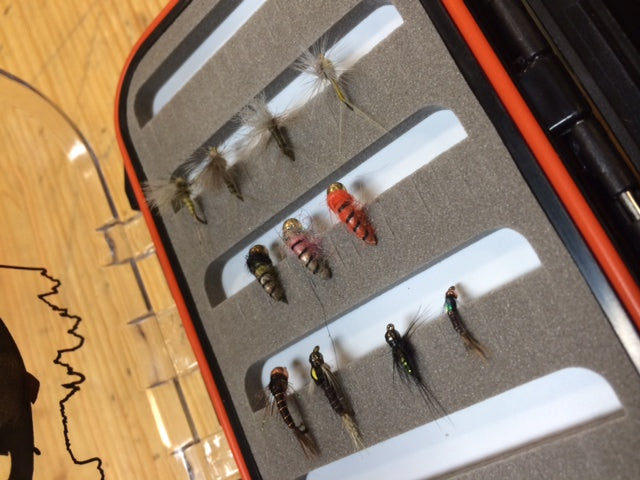
Black Hills Flies for Fall Hatches
Share
In the Black Hills, some of our best dry fly fishing can be from late August to early October. Pale Morning Duns hatch reliably through most of September, and the Baetis hatch can be good all the way through October. Trout seem to have a sweet-tooth for these two varieties of mayflies, and fly anglers can use this to their advantage. These hatches bring good numbers of fish to the surface, but that doesn't mean they'll be pushovers. If you have a basic knowledge of the insects, their life cycles, and what flies to use when, you'll enjoy more success and more fish in your net!
The four major stages of a PMD or BWO are nymphs, emergers, duns, and spinners. The nymphs are the aquatic version of the insects - the kind of thing that you see crawling all over the bottom of mid-stream rocks. Emergers are when the nymphs drift or swim up to the surface of the water, then breaking out of their exoskeleton into a flying insect - similar to a caterpillar/butterfly type life cycle. The duns are the flying, winged flavor of the mayfly. Once they mate, they go back to the water, lay their eggs, then die. This is the spinner - the last step of the cycle.
Nymphs
The nymphal forms of these insects are hugely important to trout. They have protection from predators and a constant conveyor belt of food when they're nymphing, which are really the two things a trout needs to survive day to day life. The Tungsten Split Case Baetis and PMD, as well as the Killer Mayfly Nymph pictured above are my two favorite patterns for pickier fish. Sometimes a Pheasant Tail just won't cut it, and that's when I tie these patterns on. They work great nymphed below a larger weight fly, as well as fished as a dropper fly below your dry fly or emerger.
Emergers
The emerger form of a mayfly is probably it's most vulnerable stage, and trout take serious advantage of that. The nymph develops a gas bubble underneath it's exoskeleton while on the bottom of the river, which carries it to the surface of the water column. Then, they get stuck in the surface film, and break through their exoskeleton and become the winged version of the insect - duns. While stuck in the surface tension, they're vulnerable, and the trout know this. When you're seeing rise forms but not seeing the actual fish itself break the surface, they're eating emergers. These are usually unhurried rises, and sometimes you'll just see small dimples on the surface where the fish are feeding. The key to an emerger pattern is that the body sits below the surface - imitating the nymphal shuck of the bug. The Brook's Sprout Emerger imitates this perfectly, and is easy to see, even at long distances. If you want to pick up a few bonus fish that aren't ready to commit to a dry, put on a Tungsten Split Back or Killer Mayfly below your dry 12"-18" and use your emerger as an indicator.
Duns
The dun is the mating form of the mayfly. Dry flies are the stereotypical form of fly fishing - you're fishing a floating fly to a rising fish that you can see feeding. It's pretty straightforward actually, especially because you can see the bugs, see the fish, and see how they're reacting to your flies and presentations. When I'm dry fly fishing, I spend more time watching the fish than I do casting. See how often they're rising, what they're rising to, and even which direction they seem to be favoring to feed. Making one good cast will catch you many more fish than making ten bad casts and spooking the fish. Just take your time, observe what the fish is doing, and make your cast. I guarantee you that you'll catch more fish than just wandering down to the water and starting to haphazardly cast. My two favorite mayfly dries are the CDC Thorax Dun and the Sparkle Dun, pictured above.
Spinners
After the duns mate, they return to the water to lay their eggs, then die. This is the spinner. Because they're dead, there's no escaping the hungry trout below. Fish eating these are unhurried, calculated risers. Slow and steady wins the race here. I find the fish to eat PMD and BWO emergers and duns much more eagerly than they eat the spinners, but that's just my experience. If they are eating spinners, you need to have a low lying, down wing pattern. The spinner's wings are laying on the water after they die, and trout can key on this at times.
Hopefully this helps take some of the mystery out of fishing fall Black Hills hatches for you! We're looking forward to some great fall hatches - get out here and get a piece of the action. For up to date fishing reports and conditions, give us a call at the shop at 605-341-2450. As always, thanks for reading, and good fishing!
Ryan






